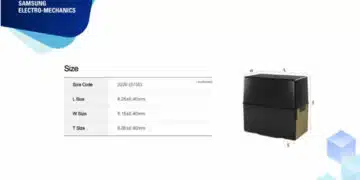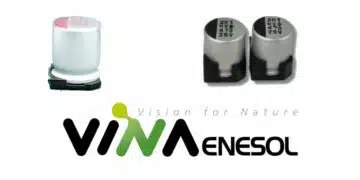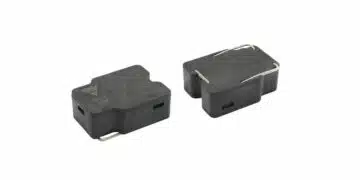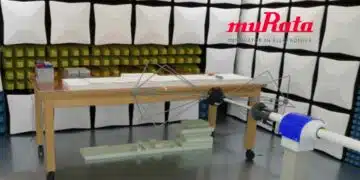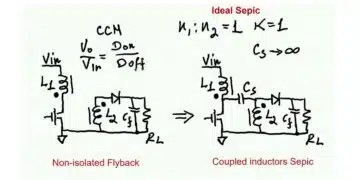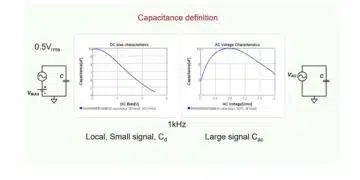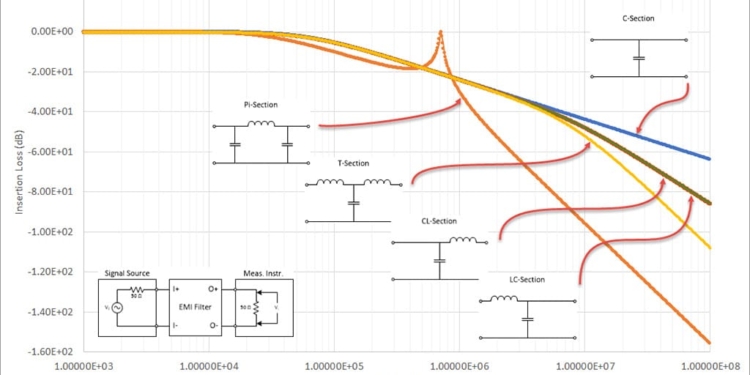Capacitors are used in both analog and digital circuits to remove unwanted signals. The filtering performance of a capacitor or filtering circuit is commonly described in terms of insertion loss. Some of the factors that significantly affect the insertion loss performance of a filtering circuit include configuration of the filtering elements, impedance, and load current.
Filtering EMI in Circuits
Electrical disturbances, both natural and man-made, can significantly affect the performance of an electronic circuit. These unwanted signals are collectively known as electromagnetic interference (EMI). Filtering circuits are used in most analog and digital circuits to eliminate these unwanted signals. Some of the most common sources of these signals include lighting, storms, precipitation, power lines, motors, ignition systems, radar transmitters, power amplifiers, computer clocks and cosmic sources.
The configuration of elements in a filtering circuit significantly determines its filtering performance. The simplest filtering configuration, commonly known as C filter, consists of a single feed-through capacitor. The performance of a filtering circuit is improved by using a combination of capacitive and inductive elements. Some of the most common configurations include L-C, T, and Pi constructions. Increasing the number of capacitive and inductive elements helps to improve the performance of a filtering circuit.
Insertion loss characteristics of capacitors and circuits
One of the key factors to consider when selecting a capacitor for EMI filtering is its insertion loss characteristics. This parameter is commonly defined as the ratio of voltage before and after a filter is added. In a basic circuit, the value is obtained by dividing the values of voltage obtained before and after a filtering component is inserted. This parameter greatly determines the level of attenuation of a filtering circuit. The insertion loss performance of a circuit or a component is commonly given in decibels.
Ordinary capacitors do not have good insertion loss performance characteristics. The presence of inherent parasitic ESL self-inductance reduces their ability to ground unwanted electrical disturbances. This residual inductance increases with an increase in the length of electrodes.
In addition, the narrower the electrode is, the higher the amount of inductance. To reduce this unwanted inductance and improve the filtering performance of capacitors, it is necessary to modify the architecture of these passive components. Changing the architecture of a capacitor and adding a third terminal helps to minimize residual inductance. Feed-through capacitors, a special class of capacitive elements that are widely used for filtering applications, are based on this modified architecture.
In capacitors with two terminals, the residual inductance is higher because the leads of a component behave as inductors. Introducing a third terminal helps to reduce the inductance component in series with the capacitive component. This significantly improves the insertion loss characteristics of a capacitor. By reducing this residual inductance, the self-resonance frequency of a filtering capacitor is increased.
Feed-through capacitors are specially designed to provide exceptional insertion loss performance. These capacitors are widely used for EMI suppression and bypassing applications. The most common designs of ceramic feed-through capacitors used in today’s filtering circuits are discoidal and tubular capacitors. Plastic film feed-through capacitors are commonly used in applications that demand high reliability.
Insertion loss variation with frequency
The insertion loss characteristics of ideal and actual capacitors are slightly different. The insertion loss of an ideal capacitor increases with an increase in frequency. In comparison, the insertion loss of an actual component increases with frequency up to a certain level. This level is known as self-resonance frequency. After this level, the insertion loss of an actual component decreases with an increase in frequency.
At frequencies higher than the resonance frequency, the insertion loss performance of a filter does not change if the residual inductance is maintained constant. Increasing or decreasing the capacitance of a component under these conditions does not affect the insertion loss. This means that a capacitor with a high self-resonance frequency is required for noise suppression at high frequencies. Components with small residual inductances should be used for such applications.
Factors that determine insertion loss performance
The insertion loss performance of a circuit or a component is determined by many factors; some of the main factors are electrical configuration, load current, source impedance, load impedance, earthing impedance, characteristics of the dielectric materials of components, and shielding integrity.
Configuration of components
Although single elements can be used to remove unwanted signals, most filtering circuits use a combination of capacitive and inductive components. The choice of configuration is mostly determined by the desired insertion loss performance. The most common configurations include C, C-L, L-C, Pi and T. See figure below:

Theoretically speaking, a single element filter yields an insertion loss of 20dB per decade while a two-element filter yields 40dB per decade. Filtering circuits with three or more elements can yield even better insertion loss performance.
Filtering circuits with multiple capacitive and inductive elements are used in circuits where high degrees of filtering performance are required. The actual insertion loss performance is determined by the actual characteristics of components used. This information is usually provided in data sheets. It is important to consider your source and load impedances when selecting a configuration for your filtering circuit.
Load Current
The effect of load current on insertion loss is significantly determined by the properties of the filtering elements used. For filtering circuits with inductive elements, the insertion loss can drop if ferrite inductors are used. The degree of this effect depends on the specific characteristics of the ferrite material.
Circuit impedances
The insertion loss performance of a filtering circuit is greatly dependent on source and load impedances. This performance is usually optimized by choosing a suitable configuration of capacitive and inductive elements.
Conclusion
Capacitors are used in both analog and digital circuits to remove unwanted signals. The filtering performance of a capacitor or filtering circuit is commonly described in terms of insertion loss. Some of the factors that significantly affect the insertion loss performance of a filtering circuit include configuration of the filtering elements, impedance, and load current.
Conventional capacitors do not yield a good insertion loss performance, and three-terminal components are used when better performance is required. For optimum insertion loss performance, filtering circuits consisting of multiple capacitive and inductive elements are used.


